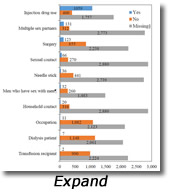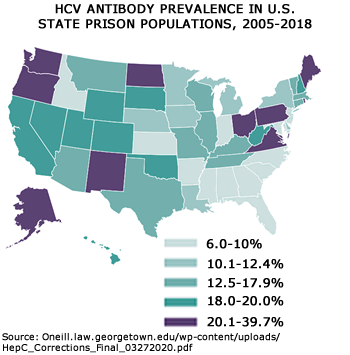 The CDC Viral Hepatitis Surveillance program has associated the following risk behavior/exposures with diagnosis of acute HCV infection during 2017:
The CDC Viral Hepatitis Surveillance program has associated the following risk behavior/exposures with diagnosis of acute HCV infection during 2017: The CDC Viral Hepatitis Surveillance program has associated the following risk behavior/exposures with diagnosis of acute HCV infection during 2017:
The CDC Viral Hepatitis Surveillance program has associated the following risk behavior/exposures with diagnosis of acute HCV infection during 2017:
Healthcare-associated transmission
Healthcare Personnel (HCP)
"The risk of acquiring hepatitis C from the workplace depends on the amount of exposure to human blood or blood products and needlestick injuries. In general, occupational groups with increased risk include workers such as healthcare workers, dentists, and laboratory personnel who are repeatedly exposed to human blood and who are at risk of needlestick injuries (CCOHS, 2017)."
During 2018, a total of 34 U.S. hospitals voluntarily reported through the Exposure Prevention Information Network (EPINet) a rate of 12.6 HCP blood and body fluid exposures per 100 average daily census days among the reporting hospitals . Similar exposures occur in other health care settings (e.g., nursing homes, clinics, and emergency departments) and during provision of in-home health care services (Moorman, 2020).
Doctor (attending.staff) specialty 40 7.8% Technologist (non-lab) 40 7.8% EMT/Paramedic/ First Responder 14 2.7% Exposure size Middle sized area(n=105)
https://internationalsafetycenter.org/wp-content/uploads/2023/06/2022-EPINet-Blood-and-Body-Fluid-Exposures-Summary-Data.pdf Healthcare-Associated Hepatitis C Outbreaks
From 2008-2019, the CDC reported a total of 43 outbreaks of HCV, 328 outbreak-associated cases, and >112,406 at-risk persons notified for screening (Chart.2):
- 16 outbreaks occurred in outpatient or long-term care facilities (including the two outbreaks of both HBV and HCV also listed above), with 134 outbreak-associated cases of HCV and >80,293 persons notified for screening
- 22 outbreaks occurred in hemodialysis settings, with 104 outbreak-associated cases of HCV and 3,134 persons notified for screening
- Four outbreaks occurred because of drug diversion by HCV-infected health care providers, with at least 90 outbreak-associated cases of HCV and 28,989 persons notified for screening
Drug injection and drug paraphernalia
People who inject drugs (PWID) have the highest risk of HCV infection of any group. HCV is efficiently transmitted via contaminated injection paraphernalia including shared needles, syringes, cookers, and filters (e.g., cotton or a cigarette filter used to strain particulates from a drug solution). HCV viral infectivity can persist for days or longer given favorable conditions, like the barrel of a used syringe.
Some studies also link HCV infection with the sharing of straws to snort cocaine. Blood to blood transfer can occur when a soda straw is shared to "sniff" illicit drugs. Past or current users of illicit drugs should be evaluated carefully, and when necessary, referred to drug treatment programs prior to antiviral therapy.
Blood products and clotting factors
Today, blood donors are screened for risk factors and blood is tested for evidence of current or previous bloodborne disease. Blood products such as clotting factors VIII and IX are now treated with inactivation methods, including heat (pasteurization), solvent/detergent process or Acidic pH inactivation. However, there is some evidence that HCV may be more or less resistant to some of these processes.
Recombinant manufacturing methods are producing a number of essential blood plasma products:
Many new recombinant blood products are working their way toward FDA approval an will have an impact on reducing the nosocomial transmission of disease.
Chronic hemodialysis
HCV is the most common hepatotropic viral infection that affects patients on maintenance hemodialysis (MHD). The prevalence of HCV in MHD patients ranges from 6–60% whereas in India various studies show a prevalence of 4.3% to 45%
|
|||
| Variables | HCV infected | Non-infected | P-value |
| Gender, No. % | |||
| Male | 5 (62.5) | 72 (78.3) | 0.50 |
| Female | 3 (37.5) | 20 (21.7) | |
| Blood Transfusion, No.% | |||
| Yes | 5 (62.5) | 43 (46.7) | 0.47 |
| No | 3 (37.5) | 49 (53.3) | |
| Kidney Transplantation, No % | |||
| Yes | 1 (12.5) | 4 (4.3) | 0.34 |
| No | 7 (87.5) | 88 (95.7) | |
| Age in Years, Mean + SD | 58.25 + 16.35 | 52.52 + 14.96 | 0.162 |
| Duration of dialysis, Months, mean + SD | 26.25 + 12.57 | 22.08 + 18.72 | 0.161 |
| Total Serum Bilirubin mg/dL | 1.0 + 0.21 | .80 + .34 | 0.63 |
| HCV prevalence among hemodialysis patients varies widely in different parts of the world. Madhavan, et al, (2020) | |||
Sexual transmission
Although not common, hepatitis C can be transmitted through sexual activity. Having a sexually transmitted infection, having sex with multiple partners, and engaging in anal sex appear to increase a person’s risk for hepatitis C. MSM with multiple sex partners who are coinfected with HCV and HIV have been shown to transmit hepatitis C.
There is no vaccine for hepatitis C.
The best way to prevent hepatitis C is by avoiding behaviors that can spread the disease, especially injecting drugs. Getting tested for hepatitis C is important, because treatments can cure most people with hepatitis C in 8 to 12 weeks (CDC 2023).
Additional resources
Prevention of Hepatitis A Virus Infection in the United States: Recommendations of the Advisory Committee on Immunization Practices, 2020. MMWR 2020; 69(5);1–38.
Prevention of Hepatitis B Virus Infection in the United States: Recommendations of the Advisory Committee on Immunization Practices. MMWR 2018;67(No. RR-1):1–31
CDC Recommendations for Hepatitis C Screening Among Adults — United States, 2020. MMWR 2020; 69(2);1–17.
Born to a HCV positive women
The overall risk of an infected mother transmitting HCV to her infant is approximately 4%–8% per pregnancy (Benova, 2014). Transmission occurs during pregnancy or childbirth; and no prophylaxis is available to protect the newborn from infection. The risk is significantly higher if the mother has a high HCV viral load, or is coinfected with HIV with which the rate of transmission ranges from 8%–15% (Benova, 2014). Most infants infected with HCV at birth have no symptoms.
Sharing personal items such as razor or toothbrushes
There is very little danger involved in sharing living space with someone infected with HCV, other than through sexual transmission. However, it is possible to become infected by contacting blood-contaminated items, such as razors and toothbrushes.
 Incarceration and HCV (Oneill Law, 2020)
Incarceration and HCV (Oneill Law, 2020)
The prevalence of HCV infection in prison inmates is substantially higher than that of the general U.S. population.
HIV co-infection
While HIV infection is not usually listed as a risk factor for HCV, they often exist as co-infections. Therefore, an infection with one should trigger testing for the other.
References
Benova, L., Mohamoud, Y.A., Calvert, C., et al. Vertical Transmission of Hepatitis C Virus: Systematic Review and Meta-analysis. Clinical Infectious Diseases. 2014;59(6):765-73.
Canadian Centre for Occupational Health & Safety (CCOHS) 2017. OSH Answers Fact Sheets. What occupations have increased risk of hepatitis C?
https://www.ccohs.ca/oshanswers/diseases/hepatitis_c.html
Canzater S., CORRECTIONAL INSTITUTIONS ARE A CRITICAL INTERVENTION POINT FOR HEPATITIS C ELIMINATION. O’Neill Institute for National and Global Health Law 2020
https://oneill.law.georgetown.edu/wp-content/uploads/HepC_Corrections_FINAL_03272020.pdf
CDC 2023. Viral Hepatitis. Hepatitis C., Accessed 3/25/2024 from https://www.cdc.gov/hepatitis/hcv/index.htm
Moorman, A.C., de Perio, M.A., Goldschmidt, R., et al. Testing and Clinical Management of Health Care Personnel Potentially Exposed to Hepatitis C Virus — CDC Guidance, United States, 2020. MMWR Recomm Rep 2020;69
Patel, P.R., Thompson, N.D., Kallen, A.J., Arduino, M.J. Epidemiology, surveillance, and prevention of hepatitis C virus infections in hemodialysis patients. Am J Kidney Dis. 2010;56:371-8.
Scheinmann, R., Hagan, H., Lelutiu-Weinberger, C., Stern, R., Des Jarlais, D.C., Flom, P.L., Strauss, S. Non-injection drug use and hepatitis C virus: a systematic review. Drug Alcohol Depend. 2007;89:1-12.
©RnCeus.com